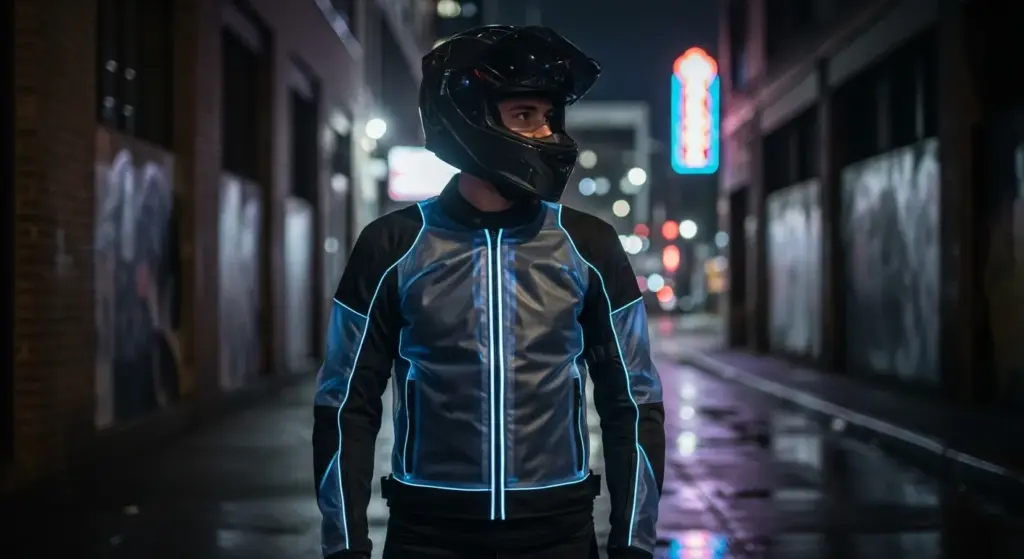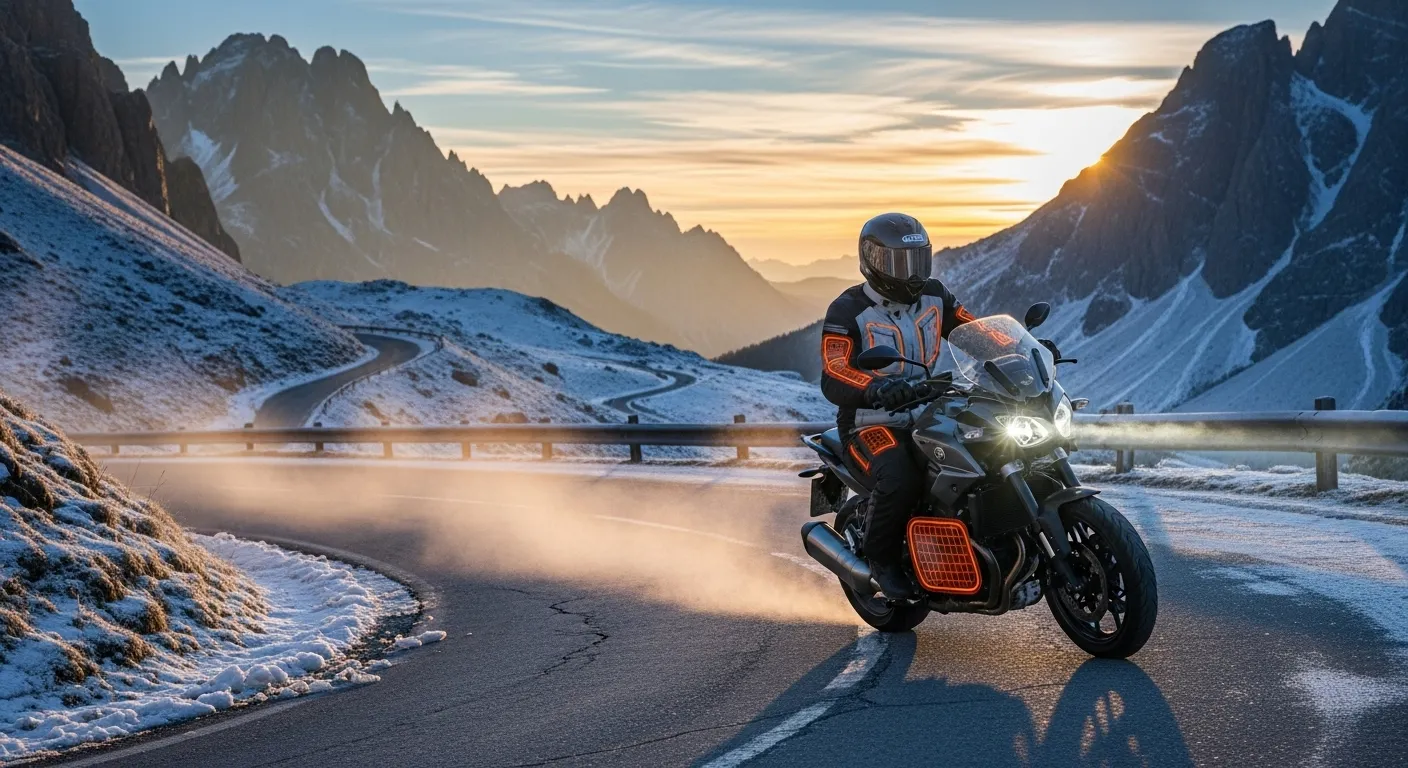If you ride long enough, you’ll know cold isn’t just uncomfortable—it’s exhausting. Your fingers go stiff, your shoulders hunch, and that confident throttle control turns cautious.
Every winter, the same debate sparks up among riders: Heated jacket or heated grips — which one actually keeps you warmer on the road?
From snowy Midwest commutes to foggy California mountain runs, every rider faces that moment when the chill bites through leather gloves and you start wondering if it’s time to upgrade your gear. And that’s exactly what’s happening this season — riders everywhere are rethinking how they stay warm on two wheels.
Let’s unpack what really matters — warmth coverage, convenience, and real-world practicality — without the marketing fluff.
The Science of Heat: What Your Body Actually Needs
When you’re riding in cold air, your body loses heat through three main routes — convection (wind), radiation (exposed skin), and conduction (touching cold surfaces like handlebars). Heated gear fights back by adding warmth faster than you lose it.
But here’s the twist — where that heat is applied makes all the difference.
- Heated grips only warm your palms, not your fingertips or the tops of your hands.
- Heated jackets radiate heat from your core — chest, back, shoulders — and when paired with heated gloves or liners, they keep your entire upper body cozy.
The human body prioritizes core warmth. When your chest and arms stay hot, your blood flow improves — keeping your hands warmer too, even before direct heat touches them.
👉 So while heated grips feel instantly nice, a jacket often wins in long-term comfort.
Micro-opinion: Most riders underestimate how much better heated clothing performs once the temperature dips below 45°F.
Heated Grips: Simple, Reliable, and Always On
Let’s give grips their due — they’re the set-and-forget option. Once installed, they draw power directly from your motorcycle’s electrical system. No batteries to charge, no wires to thread through sleeves, no forgetting gear at home.
Why Riders Love Them:
- Instant access: Just start your bike, flip the switch, and feel the warmth in under a minute.
- Durability: Most last years with minimal maintenance.
- Safe to use in rain: Waterproof designs make them great for commuters.
- Great for short rides: Perfect for early-morning errands or short work commutes.
But there’s a catch: the top of your hands stay cold. The wind hits your knuckles at 60 mph, and grips can’t help there. Even with thick gloves, you’ll feel the bite.
In very cold weather (below 40°F), heated grips alone rarely keep you warm for more than an hour.
Micro-opinion: They’re great for “chilly,” not for “freezing.”
Take a look at this post also: 5 Top Best Dirt Bike Gloves For Trail Riding

Heated Jackets: The Core-Warming Powerhouse
Heated jackets are like wearing a portable furnace. Instead of warming a small area, they heat your entire torso — where most of your blood flow originates.
When your body core stays warm, blood continues to flow freely to your hands and feet. That means even your fingers benefit indirectly.
Why Jackets Outperform Grips:
- Full-body coverage: Chest, back, shoulders, and sometimes sleeves.
- Layer-friendly: You can wear them under any riding jacket.
- Even heat distribution: No hot spots or cold patches.
- Expandable system: Many jackets plug into heated gloves, pants, and socks, creating a full heat circuit.
In freezing weather (35°F and below), a heated jacket or liner easily outperforms grips in keeping you functional and alert.
Riders who tour across states often call heated jackets “the single best winter investment.”
The only downsides? Slightly higher cost and a bit more setup time. But when you’re three hours into a cold highway ride, you’ll thank yourself for the extra effort.
Micro-opinion: Once you use a quality heated jacket, you’ll never go back to shivering in the saddle.
Take a look at this post also: 7 Proven Tips to Find Your Ideal Motorcycle Gloves

Wiring, Power & Practicality — The Real-World Details
Before you get excited, here’s the boring part that actually matters. Heated gear depends heavily on your motorcycle’s electrical system.
A standard heated jacket can draw between 7–10 amps, while heated grips use around 3–4 amps. That’s fine for adventure or touring bikes with robust alternators, but smaller bikes (under 300cc) may struggle to power both without draining the battery.
Practical Tips:
- Check your alternator output before installing multiple accessories.
- Use a fused harness — never direct-wire to your battery.
- Pair smartly: heated grips + vest for moderate cold; jacket + gloves for deep winter.
- Always carry a small voltage meter — riders who overdraw power often don’t realize until their ABS or dash starts flickering.
And yes, heated gear can fail if not installed cleanly. Loose wires or corroded connectors are common in DIY setups. Use proper weather-sealed connectors and route cables under the tank safely.
Micro-opinion: Most “gear failures” come from bad wiring, not bad products.
Comfort, Safety, and Rider Focus
Warmth isn’t just luxury — it’s riding safety. Cold fingers reduce reaction time. You brake slower, twist the throttle less precisely, and fatigue builds up faster.
A heated jacket keeps your core and muscles relaxed, so you ride smoother and longer. Heated grips only target comfort; jackets improve endurance.
Riders often overlook how much posture and focus improve when the chill is gone. You stop tensing your shoulders, your helmet visor stays clearer (because you’re not exhaling through clenched teeth), and you enjoy the ride again.
A Real-World Example:
During a test ride in Colorado’s early winter, I tried both setups. For the first hour, heated grips felt perfect — my palms were toasty. By the second hour, my knuckles were numb, and the wind had cut through. When I switched to a heated jacket, it took five minutes to feel warm head-to-toe.
That difference — comfort translating into control — is why so many veteran riders prefer jackets for long hauls.
Micro-opinion: Warm hands help you ride; a warm body helps you keep riding.
Cost Breakdown: Which One’s Worth Your Money?
| Feature | Heated Grips | Heated Jacket (or Liner) |
|---|---|---|
| Price Range (USD) | $80 – $200 | $180 – $400 |
| Installation | One-time wiring, permanent | Plug-in or battery, removable |
| Warm-Up Time | 1–2 minutes | 30–60 seconds |
| Coverage | Palms only | Full torso and arms |
| Portability | Fixed to bike | Wearable anywhere |
| Electrical Draw | 3–4A | 7–10A |
| Comfort in 40°F and below | Limited | Excellent |
| Maintenance | Minimal | Requires wire care |
That chart says it all — heated grips are convenient and cost-effective, but jackets win when temperatures truly plummet.
If you can afford both, that’s the dream combo: grips keep your hands active, jacket keeps your body alive.
Micro-opinion: The “perfect setup” for winter touring is both systems working together.
Who Should Choose What
Let’s make it simple:
- Urban commuters → Heated grips are enough. Easy install, less hassle, short rides.
- Touring & adventure riders → Heated jacket or full liner system. You’ll appreciate it over long miles.
- Occasional winter riders → Heated vest or jacket liner (cheaper than full jacket).
- Daily riders in freezing regions → Combination of both. You’ll never worry about the weather again.
And remember — no matter what setup you choose, layering and wind protection are key. Heated gear can’t fix airflow leaks or poor gloves. Always use windproof outer shells to lock in warmth.
Pro tip: If you’re going for a jacket setup, pick a dual-controller system — it lets you adjust heat for torso and gloves separately.
Verdict: The Real Winner
After years of riding in unpredictable winters and testing gear from brands like Gerbing, Warm & Safe, and Oxford, here’s the truth:
- Heated grips are convenient, affordable, and perfect for daily city riders.
- Heated jackets or liners are lifesavers for touring, mountain, and all-day rides.
- Using both together is the closest thing to “climate control” for your motorcycle.
If your goal is to stay truly warm, especially in cold wind or below-freezing temps, the heated jacket wins — hands down.
But if you’re after ease, simplicity, and minimal wiring, heated grips are still the smarter “everyday” choice.
At the end of the day, what keeps you riding longer is what wins — and for most, that’s warmth around the core.
If you’ve been waiting for a sign to upgrade your winter gear — this might just be it.
